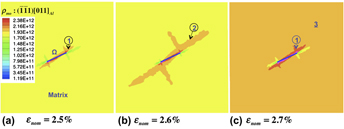Crossref Citations
This article has been cited by the following publications. This list is generated based on data provided by
Crossref.
Elkhodary, K.I.
and
Zikry, M.A.
2012.
Dynamic crack nucleation, propagation, and interactions with crystalline secondary phases in aluminum alloys subjected to large deformations.
Philosophical Magazine,
Vol. 92,
Issue. 32,
p.
3920.
Lee, W.M.
and
Zikry, M.A.
2012.
High strain-rate modeling of the interfacial effects of dispersed particles in high strength aluminum alloys.
International Journal of Solids and Structures,
Vol. 49,
Issue. 23-24,
p.
3291.
Lee, W.M.
and
Zikry, M.A.
2012.
Modeling the interfacial plastic strain incompatibilities associated with dispersed particles in high strength aluminum alloys.
Acta Materialia,
Vol. 60,
Issue. 4,
p.
1669.
Lee, W.M.
and
Zikry, M.A.
2012.
Dispersed particle and triple junction interactions in aluminum alloys.
Materials Science and Engineering: A,
Vol. 535,
Issue. ,
p.
264.
Khanikar, Prasenjit
and
Zikry, M. A.
2014.
Predictions of High Strain Rate Failure Modes in Layered Aluminum Composites.
Metallurgical and Materials Transactions A,
Vol. 45,
Issue. 1,
p.
60.
Kozmel, T.
Vural, M.
and
Tin, S.
2015.
EBSD analysis of high strain rate application Al–Cu based alloys.
Materials Science and Engineering: A,
Vol. 630,
Issue. ,
p.
99.
Elkhodary, Khalil I.
and
Bakr, Mohamed A.
2015.
Single crystal plasticity with bend–twist modes.
Journal of the Mechanics and Physics of Solids,
Vol. 79,
Issue. ,
p.
44.
Lin, Y.C.
Wang, Zong-Wei
He, Dao-Guang
Zhou, Ying
Chen, Ming-Song
Huang, Ming-Hui
and
Zhang, Jin-Long
2016.
Effects of pre-treatments on precipitate microstructures and creep-rupture behavior of an Al–Zn–Mg–Cu alloy.
Journal of Materials Research,
Vol. 31,
Issue. 9,
p.
1286.
Kozmel, T.
Vural, M.
and
Tin, S.
2016.
EBSD characterization of shear band formation in aluminum armor alloys.
Journal of Materials Science,
Vol. 51,
Issue. 16,
p.
7554.
Ragkousis, A
Bakare, F
and
Babalola, M I
2017.
The effect of re-ageing on a novel thermomechanical treatment for improving the mechanical properties of AA2139 aerospace aluminium alloys.
Materials Research Express,
Vol. 4,
Issue. 11,
p.
116525.
Cao, B.
Shaeffer, M.
Cadel, D.
Ramesh, K. T.
and
Prasad, S.
2018.
An Analysis of Strengthening Mechanisms and Rate-Dependence in a High Strength Aluminum Alloy.
Journal of Dynamic Behavior of Materials,
Vol. 4,
Issue. 1,
p.
6.
Aryshenskii, E. V.
Guk, S. V.
Galiev, E. E.
Drits, A. M.
and
Kavalla, R.
2018.
Possibility of Application of a 1565ch Alloy in the Automotive Industry.
Russian Metallurgy (Metally),
Vol. 2018,
Issue. 10,
p.
995.
2019.
Dislocation Mechanism-Based Crystal Plasticity.
p.
397.
Nguyen, Khanh
Zhang, Meijuan
Amores, Víctor Jesús
Sanz, Miguel A.
and
Montáns, Francisco J.
2021.
Computational Modeling of Dislocation Slip Mechanisms in Crystal Plasticity: A Short Review.
Crystals,
Vol. 11,
Issue. 1,
p.
42.
Elsadek, Mahmoud A.
and
Hatem, Tarek M.
2022.
TMS 2022 151st Annual Meeting & Exhibition Supplemental Proceedings.
p.
941.
